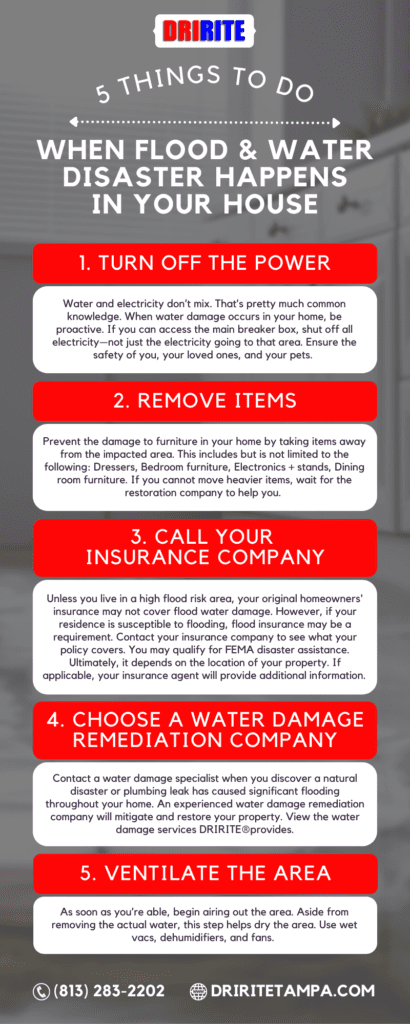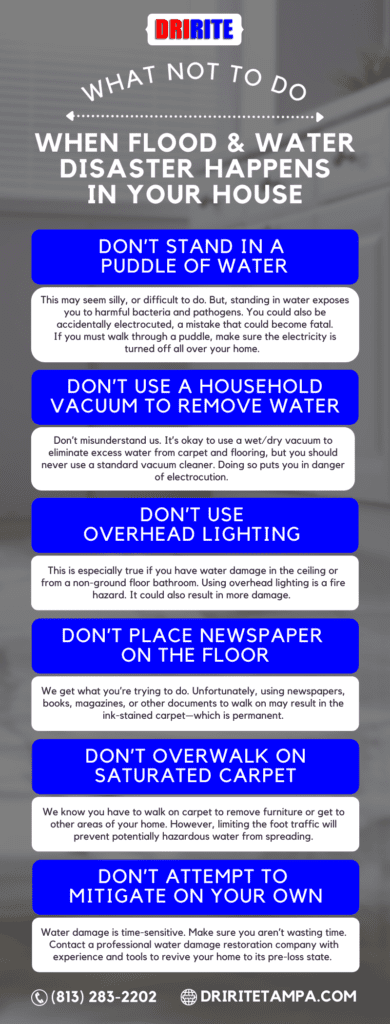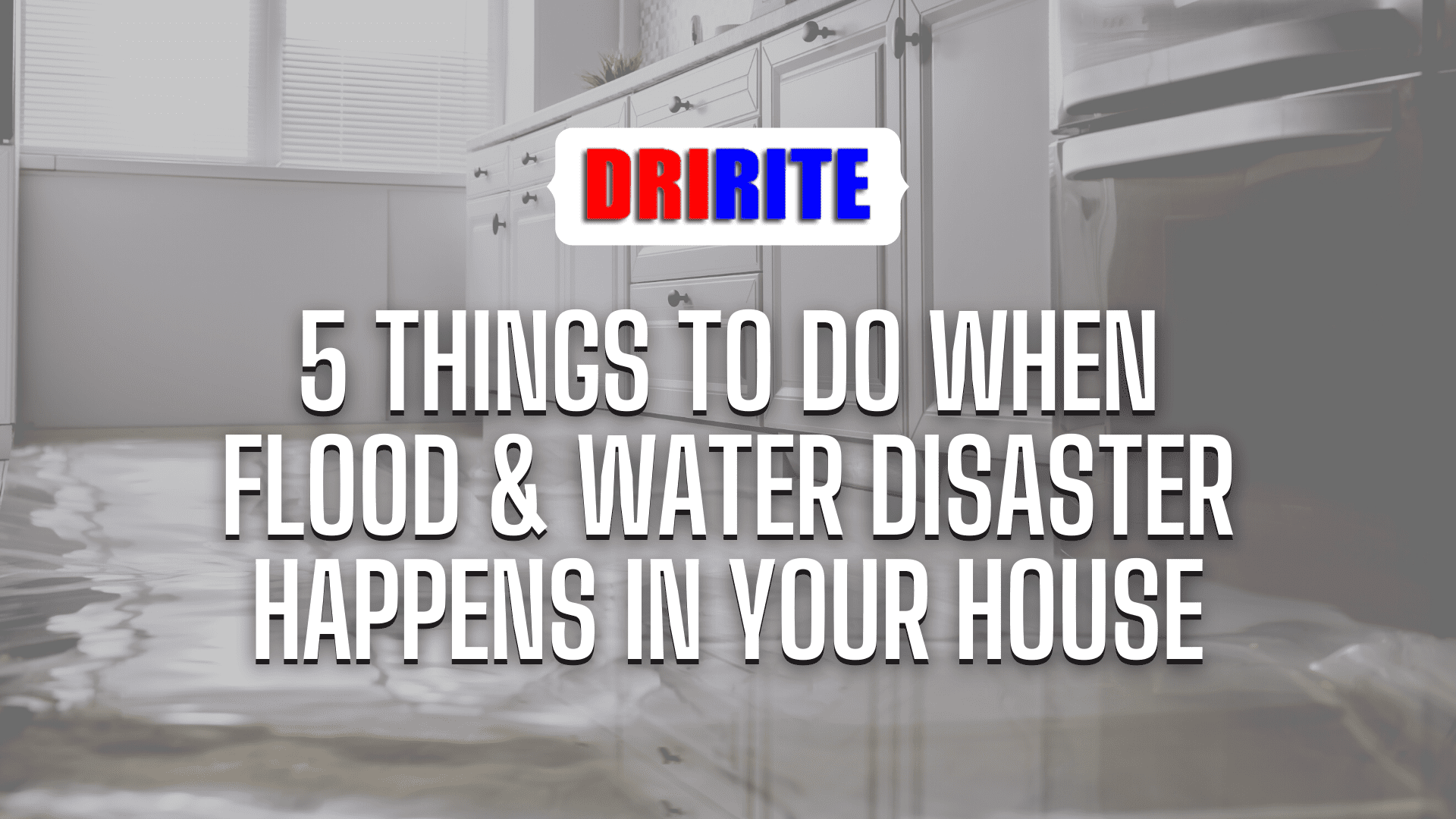When there’s a water damage emergency, you need to act fast to prevent mildew, mold growth, and other issues. In most cases, the origin of the water in your home will determine how to begin flood damage cleanup and repair. Water from home appliance leaks has different contaminants than a flooded river or backed-up sewage line. Nevertheless, you’ll need to document the severity of your property damage, contact your insurance company, and start the mitigation processes.
Listed below, we have the five most crucial things to do when a flood and water disaster happens in your house.
5 Things to Do When Flood & Water Disaster Happens in Your House

If you think there’s been a rise in natural disasters, including floods, snowstorms, and hurricanes, you’re not alone. According to the 2020 Ecological Threat Register, natural disasters have increased tenfold since 1960.
1. Turn Off the Power
Water and electricity don’t mix. That’s pretty much common knowledge. When water damage occurs in your home, be proactive. If you can access the main breaker box, shut off all electricity—not just the electricity going to that area. Ensure the safety of you, your loved ones, and your pets.
2. Remove Items
Prevent the damage to furniture in your home by taking items away from the impacted area.
This includes but is not limited to the following:
- Dressers
- Bedroom furniture
- Electronics + stands
- Dining room furniture
If you cannot move heavier items, wait for the restoration company to help you.
Tip: Before you remove anything from the room, take photographs and videos of the damage. Documentation will help when filing an insurance claim.
3. Call Your Insurance Company
Unless you live in a high flood risk area, your original homeowners’ insurance may not cover flood water damage. However, if your residence is susceptible to flooding, flood insurance may be a requirement. Contact your insurance company to see what your policy covers.
You may qualify for FEMA disaster assistance. Ultimately, it depends on the location of your property. If applicable, your insurance agent will provide additional information.
4. Choose a Water Damage Remediation Company
Contact a water damage specialist when you discover a natural disaster or plumbing leak has caused significant flooding throughout your home. An experienced water damage remediation company will mitigate and restore your property. View the water damage services DRIRITE®provides.
5. Ventilate the Area
As soon as you’re able, begin airing out the area. Aside from removing the actual water, this step helps dry the area. Use wet vacs, dehumidifiers, and fans.
Listed below, we also have the most crucial things not to do when a water and flood disaster happens in your house.
What Not to Do When Flood & Water Disaster Happens

When water damage happens you may go into a full-on panic, or you may pass it off as a minimal issue that can be fixed with a little airflow. Whatever you may think, keep in mind that water damage is time-sensitive. The longer you wait to begin water removal, the more severe your damages will be.
Let’s discuss a few more things you should avoid doing when you have flood and water damage in your house.
Don’t stand in a puddle of water
This may seem silly, or difficult to do. But, standing in water exposes you to harmful bacteria and pathogens. You could also be accidentally electrocuted, a mistake that could become fatal.
If you must walk through a puddle, make sure the electricity is turned off all over your home.
Don’t use a household vacuum to remove water
Don’t misunderstand us. It’s okay to use a wet/dry vacuum to eliminate excess water from carpet and flooring, but you should never use a standard vacuum cleaner. Doing so puts you in danger of electrocution.
Don’t use overhead lighting
This is especially true if you have water damage in the ceiling or from a non-ground floor bathroom. Using overhead lighting is a fire hazard. It could also result in more damage.
Don’t place newspaper on the floor
We get what you’re trying to do. Unfortunately, using newspapers, books, magazines, or other documents to walk on may result in the ink-stained carpet—which is permanent.
Don’t overwalk on saturated carpet
We know you have to walk on carpet to remove furniture or get to other areas of your home. However, limiting the foot traffic will prevent potentially hazardous water from spreading.
Don’t attempt to mitigate on your own
Water damage is time-sensitive. Make sure you aren’t wasting time. Contact a professional water damage restoration company with experience and tools to revive your home to its pre-loss state.
Contact Our Water Damage Restoration Technicians for Comprehensive, Reliable Service
As we mentioned above, water damage is time-sensitive. As much as you love to get your hands dirty, flood and water disasters are no place for DIY projects. Instead, trust DRIRITE®s trained professionals to revive the condition and quality of your residence. We provide residential and commercial water damage restoration services to the communities of Tampa Bay.
Our team of water removal specialists guarantees all of our projects against secondary damages. We’ll monitor your project daily, utilizing infrared imaging cameras and other tools to ensure accuracy and efficiency during the drying process.
Call DRIRITE®. It’s Not Just Our Name, It’s Our Guarantee™.

Chief Executive Officer
Mike Campbell is a highly experienced professional specializing in structural drying, mold remediation, and environmental consulting. With certifications such as OSHA HAZWOPER, council-certified microbial remediator, and state of Florida licensed mold remediator, he offers tailored solutions to clients at DriRite. With specialized training from the IICRC, Mike is equipped with advanced skills in categories such as applied structural drying, commercial drying, and water damage restoration. This expertise allows him to deliver comprehensive and effective solutions to water-related issues. His dedication to providing exceptional service and expertise makes him a valuable resource in the field.
Comments are closed.



